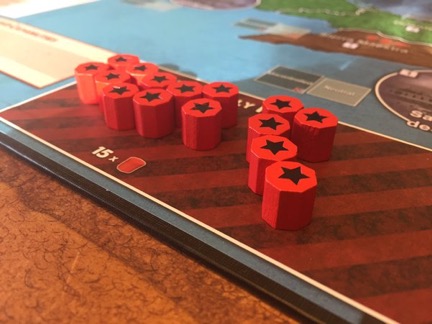Cuba Libre is the second game in the COIN series that is produced by GMT games. The game designers; Jeff Grossman and Volko Ruhnke, clearly spent a significant amount of time researching and studying Castro’s rise to power, and that time and effort really rises to the surface during play. So here’s a few thoughts after playing Cuba Libre, as the Govt. and Syndicate factions, and how it differs from other COIN games.

Size
The most obvious difference between Cuba Libre and other COIN games is the size of everything in the box. The board is a humble 22 x 17 inches and boasts a grand total of 13 game spaces. Most of which are arranged dividing up the island in a mainly linear fashion, meaning you must pass through one space to the get the rest of the spaces. Below is a picture of the initial set up and as you can see, the board is pretty sparse with units, but in comparison to games like Liberty or Death (LoD) and Fire in the Lake (FitL) so too are the faction available forces.

Something that became very evident as the game progressed was the layout of the map made movement throughout the game somewhat predictable. What I mean by that is that you can march east or west, and that’s about it. Forces massing in one space had usually two options of movement or a third at most if Economic Centers or cities were viable move options. At first look, I was concerned that the map layout would take some of the excitement out of the game – playing FitL as the NVA and VC was very fun because there were so many options from which to launch surprise attacks and the sides had to constantly consider flanking maneuvers. All in all however the map actually created it’s own, very different, kind of tension. Where battle lines were drawn became key and making sure they were well enforced was a constant concern. Watching the red and yellow cylinders creep up the map was terrifying at times, because of the limited number of Govt. forces and police are also limited in number.
Action
The action is immediate and swift. Whilst playing Liberty or Death I noticed that the game starts with so much of the map uncontrolled and positioning and territory are something that you have to capture early on in the game. In Cube Libre the very first couple of event cards resulted in all sorts of Ops, including terror, rallying, assaults and others. Barely had that first card turned over than we were at each others’ throats. And it felt awesome! I loved being thrown in the deep end, so to speak, and learning how my factions worked on the fly. There was little time to feel the enemy out and spar a few rounds of combat.
Event Cards
The event deck contains a whopping 48 cards. Plus an additional 4 propaganda cards. This boils down to each faction having at most 12 cards that are extremely beneficial for them, and it could be less if you use the even shorter game option of removing 8 cards! This means that special abilities from cards are at a premium and if you can get them early then by all means do, but later in the game they are much less desirable, because you will need those precious ops to be competitive in this game. Mathematically speaking you will be able to execute an Op or EC only 24 times, if you took 1/2 of your ECs then you’d be left with 18 ops and a smattering of special activities in order to achieve victory conditions. That doesn’t sound like a lot, and it isn’t. Getting caught up in a quagmire in certain provinces can be deadly, and knowing when to retreat can save you the game.
As you can see above, things in the south got a little out of hand for the Govt. forces and and a well timed tactical withdrawal during a propaganda card was needed in order to stop 26th July forces from taking those precious resources. But all in all this game is much shorter than other COIN games and that puts your actions at a premium, and makes being stuck with a Limited Op feel very tight.
Wrap up
Cuba Libre was an absolute blast to play, we just jumped in and started playing. No one knew a lot of the historical aspects of the game, or how each of the factions played out in real life [Grant knew a bit about the Syndicate and their profiteering] but having played through and read the events and, personally, having read the play book I feel much more informed about the revolution. Now I just need to find a good book about it! [Post recommendations in the comments, please!] The game is elegant in the way that all the COIN games are, and well balanced. But Cuba Libre is very fast paced and very action packed. Each Op carries so much weight and maximizing your impact with each eligibility can turn the game in your favor.
So go ahead, dive in and grab yourself a copy of this game so that you can write your own version of history! HUYE BATISTA!
-Alexander




